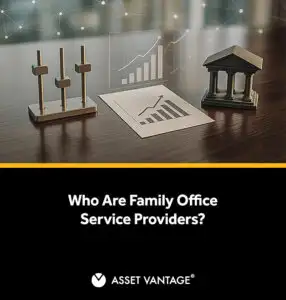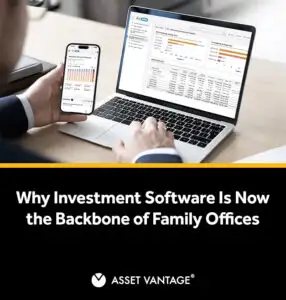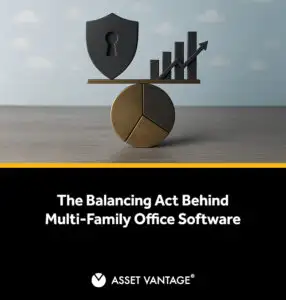Read Time12 Mins
- What Is a Family Office and Why Families Need One
- Family Office Models: A Comparative View
- The Role of Multi-Family Offices in Wealth Oversight
- How Multi-Family Offices Provide Governance
- When Families Should Consider a Multi-Family Office
- Core Multi-Family Office Services
- How Multi-Family Offices Support Family Governance
- Investment Opportunities Through Multi-Family Offices
- Benefits of Multi-Family Offices for Wealthy Families
- Challenges in Multi-Family Office Structures
- How Multi-Family Offices Evolved Over Time
- The Future of Multi-Family Office Services
What Is a Family Office and Why Families Need One
A family office is a dedicated structure that manages a family’s financial affairs, investment management, and long-term governance. Instead of relying on fragmented advisors, it creates a single point of control to oversee accounting, reporting, tax planning, and estate matters. The goal is simple: protect family wealth, reduce complexity, and build continuity across multiple generations.
The Purpose of Family Offices
Family offices exist because wealthy families face unique challenges. Managing diverse asset classes, coordinating tax services, and planning succession requires more than a traditional wealth management firm or private bank can deliver. A modern family office provides:
- Investment management that aligns the family’s assets with long-term goals
- Risk oversight across financial markets, private equity, and alternative investments
- Comprehensive financial services including reporting, financial planning, and bill pay
- Family governance frameworks that reduce disputes and preserve the family’s legacy
Why Wealthy Families Create Family Offices
High-net-worth families often reach a stage where managing wealth through multiple advisors becomes inefficient and risky. A family office typically consolidates services into one system, allowing family members to pool resources and gain specialized support. The benefits include:
- Financial planning that integrates investment strategy with tax and estate planning
- Tax services that minimize tax liabilities while complying with evolving tax laws
- Investment advisory services that open access to private equity, hedge funds, and other investment opportunities
- Succession planning that ensures the smooth transfer of the family’s assets to future generations
By consolidating the family’s financial affairs under one roof, family offices give client families clarity, cost savings, and professional oversight. For some, that means creating a single-family office with maximum personalization. For others, it leads to joining a multi-family office, where multiple families share costs while still accessing the same services.
Family Office Models: A Comparative View
Single-Family Office: Built for One Family
The benefits include:
- Maximum personalized service tailored to one family’s assets and priorities
- Full privacy, since all reporting covers only the family’s financial affairs
- Control over governance and succession planning without balancing the needs of multiple families
Multi-Family Office: Serving Multiple Families
- Cost sharing, with fees either asset-based or fixed, lowers the burden for each family.
- Comprehensive services such as accounting, reporting, tax services, and succession planning.
- Exposure to broader investment opportunities, including private equity, hedge funds, and alternative asset classes.
- Access to networks of financial professionals, registered investment advisors, and money managers.
| Feature | Single-Family Office | Multi-Family Office |
|---|---|---|
| Families served | One family | Multiple families |
| Cost | Higher, fully borne by one family | Shared across families (cost savings) |
| Personalization | Maximum, designed for one family | Moderate, same services offered to multiple clients |
| Scale & Networks | Limited to one family’s assets | Broader access to financial advisors, asset classes, and investment opportunities |
| Governance | Family controls all decisions | Governance shared with a framework to balance families served |
Hybrid Models Across the Financial Service Industry
Not every structure fits neatly into one model. Many family offices now adopt hybrid approaches. A hybrid model combines the personalized service of a single-family office with the broader reach of a wealth management firm or multi-family office services.
Examples include:
- Families are retaining a lean single-family office while outsourcing specialized services such as risk management or charitable giving.
- Partnerships where several families pool resources for investment advisory while maintaining separate governance of their families’ assets.
- Collaborations with the financial service industry where private banks or external advisors manage reporting, bill pay, and compliance.
The Role of Multi-Family Offices in Wealth Oversight
A multi-family office is more than a shared administrative service. It is a professional framework that allows multiple families to manage their family’s financial affairs, governance, and reporting under one roof. By combining investment management, accounting, and risk oversight, multi-family offices create structures where wealthy families might otherwise rely on fragmented advisors.
Oversight Beyond Investments
- Consolidated accounting and reporting that shows the entire wealth across asset classes, entities, and generations.
- Investment advisory services that integrate public markets with private equity, hedge funds, and specialized services.
- Tax planning and estate solutions that manage tax liabilities while aligning succession planning and charitable giving with long-term goals.
- Risk management that addresses regulatory compliance, market volatility, and cross-border exposure.
These are not optional services offered. They are the foundation of comprehensive financial services designed for continuity.
Why Oversight Matters
Without disciplined oversight, wealthy families risk inconsistent reporting, duplication of costs, and gaps in tax and regulatory compliance. A modern family office solves this by combining professional management with family values. For many high-net-worth families, a multi-family office offers the right balance of cost savings, professional governance, and access to investment opportunities that would be difficult to secure alone.
How Multi-Family Offices Provide Governance
A single-family office builds governance around the priorities of one family. A multi-family office, by contrast, must design structures that work for more than one family while preserving confidence across client families.
- Standardized reporting that ensures transparency across multiple clients.
- Dispute resolution processes that protect family wealth and reduce conflict.
- Cost-sharing frameworks that define how services offered are allocated fairly.
These structures allow families to benefit from professional oversight without sacrificing accountability. Governance, when managed well, makes the difference between efficiency and friction in a multi-family office.
When Families Should Consider a Multi-Family Office
A multi-family office is not necessary for every wealthy family. It becomes the right choice when the complexity of wealth oversight exceeds what traditional advisors or a single-family office can efficiently manage on their own.
Traditional advisors may deliver investment advice, tax services, or estate planning, but they rarely integrate these functions into one reporting framework. A single-family office offers that integration, but at a cost that only the largest fortunes can justify. A multi-family office bridges the gap by providing the same comprehensive financial services to more than one family, with shared governance and cost efficiency.
Families should consider joining a multi-family office when:
- Wealth complexity grows: managing diverse asset classes, international holdings, or private equity requires institutional systems.
- Costs of a single-family office outweigh benefits: high fixed costs make sense for only a few ultra-high net worth families, while cost sharing delivers efficiency.
- Multi-generational needs emerge: succession planning, charitable giving, and governance structures must cover multiple generations.
- Professional oversight is required: families served gain access to financial advisors, registered investment advisors, and wealth management services not available through smaller setups.
- Consolidated reporting is critical: client families benefit when the entire wealth picture, including bill pay, tax liabilities, and investment opportunities, is tracked in one structure.
For many high-net-worth families, a multi-family office provides the balance of personalized service, cost savings, and comprehensive services that make long-term wealth preservation sustainable.
Core Multi-Family Office Services
A multi-family office delivers more than investment oversight. It offers a suite of comprehensive financial services that integrate accounting, reporting, tax, and financial planning under one structure. For wealthy families, this coordination reduces duplication, strengthens governance, and ensures the family’s financial affairs are managed with professional discipline.
Accounting and Reporting for Multiple Families
Consolidated reporting is one of the most valuable services offered. It allows family members to see the entire wealth picture across accounts, entities, and generations. By tracking asset classes ranging from public equities to private equity and alternative investments, multi-family offices create transparency that individual advisors rarely achieve.
Investment Advisory Services and Strategy
- Investment advice tailored to long-term objectives and family wealth preservation.
- Access to asset management expertise across public markets, private equity, and hedge funds.
- Exposure to specialized services and direct investment opportunities is often reserved for institutional investors.
Tax and Estate Planning Solutions
Multi-family offices coordinate tax planning with estate planning to manage complex tax liabilities and cross-border structures. Services include:
- Designing strategies for succession planning across multiple generations.
- Structuring charitable giving in line with family governance principles.
- Ensuring compliance with evolving tax laws while protecting the family’s assets.
Risk Management and Regulatory Compliance
- Monitoring exposure to global financial markets.
- Ensuring compliance with regulatory requirements across jurisdictions.
- Coordinating with external registered investment advisors and money managers to safeguard capital.
Concierge and Lifestyle Management
- Coordinating bill pay and expense oversight.
- Managing travel and lifestyle arrangements.
- Overseeing property, staffing, and other private obligations.
How Multi-Family Offices Support Family Governance
- Succession planning that ensures a smooth transfer of family wealth and responsibilities.
- Policies for charitable giving and philanthropy that reflect shared family values.
- Formal structures to help family members participate in decision-making without creating conflict.
Investment Opportunities Through Multi-Family Offices
Private Equity and Alternative Investments
Wealth management services in a multi-family office extend far beyond public markets. Families served benefit from:
- Private equity allocations and co-investment opportunities.
- Access to hedge funds and other specialized services.
- Exposure to infrastructure, venture capital, and other alternative asset classes.
These opportunities help preserve and grow family wealth by diversifying beyond public equities.
Direct Investment Strategy for Families
A modern family office also supports families who prefer more control. With guidance from financial advisors and investment advisors, families served can:
- Build tailored investment strategies that reflect shared values and risk appetite.
- Pursue direct investments in private companies, real estate, or sector-specific opportunities.
- Pool resources with other client families to enter deals requiring greater scale.
Comparing Investment Access
| Opportunity Type | Traditional Advisors | Single-Family Office | Multi-Family Office |
|---|---|---|---|
| Public equities & bonds | Common | Common | Common |
| Private equity | Limited | Available, but restricted to one family’s scale | Regular allocations & co-investments are pooled across families served |
| Hedge funds | Selective | Available with high minimums | Broader, vetted access shared among multiple clients |
| Direct investments | Rare | Possible but limited to one family’s networks | Guided by financial professionals, pooled opportunities with other families |
| Specialized services (infrastructure, VC) | Limited | Selective, based on one family’s reach | Integrated into wealth management services and offered across multiple families |
Benefits of Multi-Family Offices for Wealthy Families
For wealthy families, the value of a multi-family office lies in combining comprehensive financial services with efficiency and institutional oversight. Families gain clarity, save costs, and build continuity across multiple generations without bearing the full expense of a single-family office.
Cost Sharing and Efficiency Gains
The most direct benefit is cost savings. By pooling resources, multiple families can access specialized services that would be too expensive alone. Instead of one family shouldering the full infrastructure, fees are spread across the families served.
| Cost Element | Single-Family Office | Multi-Family Office |
|---|---|---|
| Staffing (CFO, accountants, legal) | Fully borne by one family | Shared across client families |
| Technology and reporting systems | High fixed cost | Shared access to institutional platforms |
| Advisory fees | Customized, higher | Lower asset-based fee through pooled resources |
Access to Expertise and Networks
- Guidance from registered investment advisors and independent financial advisors.
- Connections with money managers and professionals across the financial service industry.
- Broader networks for investment opportunities, co-investments, and direct deals.
Continuity Across Generations
Challenges in Multi-Family Office Structures
Balancing Personalized Service With Scale
Transparency and Cost Structures
Privacy and Confidentiality Across Families
How Multi-Family Offices Evolved Over Time
- World War II era: Families with industrial and trading wealth began pooling resources for accounting and reporting, as economic shifts demanded greater oversight.
- 1960s–1980s: Changes in tax laws and estate structures increased demand for centralized offices that could integrate tax and estate planning.
- 1990s–2000s: Expansion of global financial markets and new asset classes such as hedge funds and private equity drove families to adopt broader investment advisory models.
- Today: The multi-family office typically provides institutional-grade reporting, access to deal flow and pooled investment opportunities, comprehensive services such as bill pay, and governance frameworks that preserve family wealth across multiple generations.
The Future of Multi-Family Office Services
Technology in Wealth Management Services
Global Trends in the Financial Service Industry
- Expansion of wealth management services into alternative asset classes.
- Greater regulatory oversight to strengthen governance and investor protection.
- Integration of sustainability and impact investing into the investment strategy.
- Collaboration with private banks and financial professionals to deliver a broader range of specific services.







